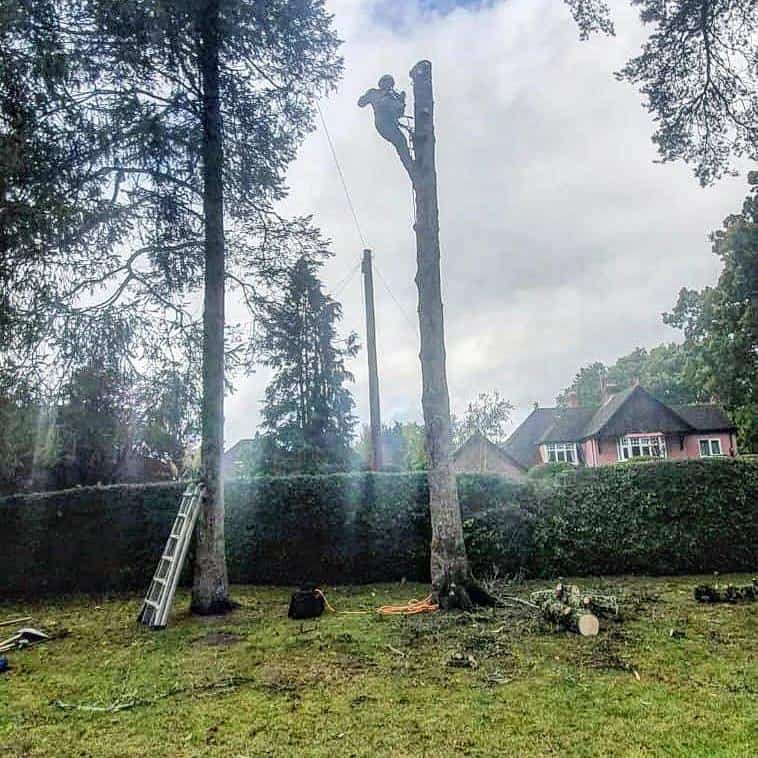Outdoor dining areas are a great way to enjoy your garden and entertain guests, but when trees overhang these spaces, it can create several problems. From debris and leaves falling onto tables to limited natural light and blocked views, overhanging trees can detract from the overall enjoyment of your outdoor space. The good news is that tree surgery offers solutions to address these issues—primarily through crown reduction or trimming.
At NS Tree Surgery Cobham, we specialise in providing professional tree care services, including crown reduction and trimming, to enhance the safety, aesthetics, and functionality of your outdoor areas. In this blog post, we will explain the difference between crown reduction and trimming, and help you decide which option is best for your outdoor dining space.
Crown Reduction vs Trimming: What’s the Difference?
Before we delve into the benefits of each technique, it’s important to understand the difference between crown reduction and trimming.
1. Crown Reduction
Crown reduction involves selectively cutting back the branches of a tree to reduce its overall size and shape while maintaining the tree’s natural form. This technique reduces the height and spread of the tree, and is often used for trees that have grown too large or are obstructing buildings, power lines, or outdoor spaces like patios or dining areas.
- Selective pruning: Only certain branches are removed, ensuring the tree retains its natural shape.
- Reduction of tree size: The overall size of the tree is reduced, making it more manageable and preventing overhanging branches from blocking light or causing damage.
- Long-term health: Crown reduction is usually a more comprehensive approach, allowing the tree to grow back healthily and without the risk of regrowth in problematic areas.
Crown reduction is an ideal solution if your tree has grown significantly and is starting to affect your outdoor dining area, as it addresses the root cause—excessive growth—while preserving the health of the tree.
2. Trimming (or Crown Thinning)
Trimming, or crown thinning, involves cutting back a tree’s branches to reduce density but not the size. The aim of trimming is to improve light penetration and air circulation by removing some of the smaller, less vital branches. This method doesn’t necessarily reduce the overall size of the tree but can be an effective way to make your outdoor space more enjoyable.
- Removing smaller branches: Trimming focuses on removing small branches to improve light and airflow without reducing the size of the tree.
- Less invasive: Trimming is a less invasive technique than crown reduction, as it doesn’t significantly alter the shape or size of the tree.
- Enhances tree health: By removing dead, diseased, or weak branches, trimming promotes overall tree health and encourages better growth.
Trimming may be the best choice if the tree is not excessively large but simply needs a little maintenance to reduce overcrowding and improve light levels in your outdoor space.
Which Option Is Best for Your Outdoor Dining Area?
1. When to Choose Crown Reduction
If your tree is large, overgrown, or poses a significant risk of obstructing your outdoor dining area, crown reduction may be the ideal solution. Crown reduction is particularly effective in the following situations:
- Excessive height or width: If the tree has grown too tall or wide and is overhanging the dining area, crown reduction helps to reduce the overall size and prevent branches from dropping or blocking sunlight.
- Safety concerns: Large overhanging branches may present a safety risk, especially in high winds or storms. Crown reduction can mitigate this risk by removing any dangerous or heavy branches.
- Tree health and structure: If the tree is in danger of becoming unbalanced due to uneven growth, crown reduction can help to redistribute the weight and ensure its long-term health.
Crown reduction is the more significant intervention and is best suited for trees that have become too large for their environment or are causing consistent issues in your outdoor space.
2. When to Choose Trimming
Trimming (or crown thinning) is generally the better choice if the tree is still relatively healthy and doesn’t need significant size reduction but could benefit from improved light, air circulation, and overall aesthetics. Trimming is ideal in the following circumstances:
- Light penetration: If you want to allow more sunlight into your outdoor dining area without reducing the size of the tree, trimming can remove some of the smaller branches that block light.
- Improving air circulation: By removing dense foliage, trimming can improve airflow, preventing moisture buildup that could lead to disease or mould.
- Preserving tree shape: If the tree is still relatively small or well-shaped, trimming can help maintain its natural form while improving the overall quality of your outdoor space.
Trimming is a less invasive, more subtle option for trees that don’t require drastic changes but would benefit from a little maintenance and fine-tuning.
How Professional Tree Surgery Can Help
While both crown reduction and trimming can be done by homeowners in some cases, hiring a professional tree surgeon is highly recommended. A professional will:
- Ensure the right technique: A qualified tree surgeon will assess your tree and decide whether crown reduction or trimming is the best solution for your needs.
- Preserve tree health: Proper techniques are essential to ensure that your tree remains healthy after the procedure. Professionals have the experience to make clean cuts that prevent damage to the tree.
- Provide safety: Tree surgery can be dangerous, especially when working at height. A professional tree surgeon has the proper equipment and safety training to complete the job safely.
At NS Tree Surgery Cobham, we provide expert crown reduction, trimming, and other tree surgery services to help homeowners create safe, enjoyable outdoor spaces while maintaining the health of their trees.
Conclusion
Both crown reduction and trimming have their unique advantages when it comes to managing trees that overhang outdoor dining areas. Crown reduction is ideal for large, overgrown trees that need significant size reduction, while trimming is more suited for trees that simply require thinning to improve light and airflow. By choosing the right tree surgery option, you can maintain the health and safety of your tree while enhancing the enjoyment of your outdoor space.
If you have a tree that is overhanging your outdoor dining area in Cobham, Surrey, and you’re unsure whether crown reduction or trimming is the best solution, contact NS Tree Surgery Cobham today. Our experienced team will assess your tree and provide a tailored solution to meet your needs. Don’t wait for the problem to get worse—take action today to ensure the safety and enjoyment of your outdoor space.
Call us on: 01372 679 098
Click here to find out more about NS Tree Surgery Cobham
Click here to complete our contact form and see how we can help with your tree needs.

